#Massachusetts bay transportation authority
Explore tagged Tumblr posts
Text

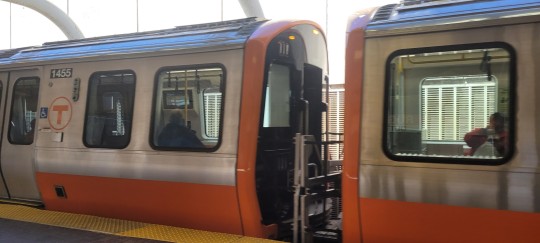
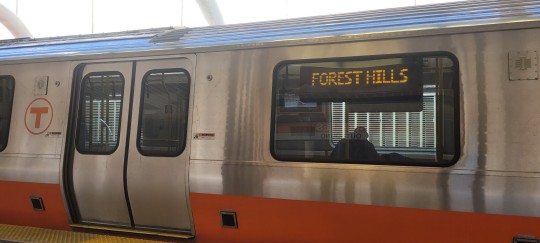
CRRC Orange Line 🧡
03/31/2024
#boston#mbta#massachusetts#trains#boston transit#train#transit#american transit#boston massachusetts#mine#american rail#railfanning#railfan#public transportation#massachusetts transit#public transit#public transport#orange line#orange line mbta#crrc#crrc trains#passenger train#train fan#massachusetts bay transportation authority#eethend speaks
8 notes
·
View notes
Photo

After dousing the red marker lights, Amtrak Downeaster Train 683 behind P42 197 will ready to run north to Portland after a 35-min. layover in Boston's North Station. Two MBTA trains flank Amtrak, and new F59s are on order to replace the aging F40s. MBTA reaches five destinations out of this depot, including Rockport, Mass. October 2012
#downeaster#commuter train#amtk#amtrak#mbta#massachusetts bay transportation authority#2012#boston#portland#trains#passenger train#history#boston north station#massachusetts
35 notes
·
View notes
Text

ok MBTA i didn't know you were freaky like that
#i was not familiar with her game#boston#she Massachusetts on my bay til I transportation authority 😫
3 notes
·
View notes
Photo

Boston Massacre
The Boston Massacre, or the Incident on King Street, occurred in Boston, Massachusetts, on 5 March 1770, when nine British soldiers fired into a crowd of American colonists, ultimately killing five and wounding another six. The massacre was heavily propagandized by colonists such as Paul Revere and helped increase tensions in the early phase of the American Revolution (c. 1765-1789).
Background
In the mid-1760s, the Parliament of Great Britain attempted to directly tax the Thirteen Colonies of British North America to raise revenue in the aftermath of the expensive Seven Years' War (1756-1763). Although Parliament believed it was well within its authority, the American colonists disagreed; as subjects of the British Crown, the colonists believed they enjoyed the same rights as all Britons, including the right of self-taxation. Since the colonists were unrepresented in Parliament, they contended that Parliament had no power to directly tax them; prominent colonists like Samuel Adams (1722-1803) of Boston argued that the Americans would be resigning themselves to the status of 'tributary slaves' if they consented to pay the Parliamentary tax (Schiff, 73).
In April 1765, news reached the colonies that Parliament had issued the Stamp Act, a direct tax on all paper documents. The outraged colonists protested the Stamp Act in a variety of ways; the Virginia House of Burgesses passed a series of resolves denouncing the act as a violation of Americans' rights, while colonial merchants began boycotting British imports. However, the most dramatic opposition to the Stamp Act took place in Boston, the capital of the Province of Massachusetts Bay. On 14 August 1765, a mob of Bostonians hanged an effigy of Andrew Oliver, the stamp distributor for Massachusetts, from an elm tree before viciously ransacking his house that evening. Fearing for his life, Oliver resigned the next day, but the mob was unsatisfied; on 26 August, it attacked the home of Lieutenant Governor Thomas Hutchinson of Massachusetts, stealing all movable goods from the house. These riots were celebrated throughout the colonies; the Sons of Liberty, a loosely organized group of colonial political agitators, dated its founding from the riots, while the elm tree on which Oliver's effigy was hanged became known as Boston's 'Liberty Tree'.
Parliament repealed the Stamp Act in March 1766, but the colonists barely had time to celebrate before a new set of taxes and regulations, the Townshend Acts, were passed by Parliament between 1767 and 1768. These acts imposed new duties on goods such as glass, paint, and tea, and required a Board of Commissioners to set up headquarters in Boston to oversee the collection of the taxes. When the five commissioners arrived in Boston in November 1767, they were greeted by a hostile crowd carrying effigies and wearing labels that read, "Liberty & Property & no Commissioners" (Middlekauff, 163). Nor did the commissioners receive a much warmer welcome from Boston's leading citizens; John Hancock (1737-1793), one of the city's wealthiest merchants, refused to allow his Cadet Company, a military organization he operated, to participate in a parade held to welcome the commissioners. Eager to put men like Hancock in his place, the commissioners seized Hancock's sloop, the Liberty, on 10 June 1768, on the pretext that the Liberty had transported contraband goods and that its captain had threatened a tax collector.
When British sailors arrived to take possession of the Liberty, they were greeted by a mob, who were already angry that the British had been impressing Boston sailors into the Royal Navy. A brawl broke out along the docks that soon blossomed into a city-wide riot, as thousands of colonists roamed the streets beating up tax collectors and attacking the commissioners' homes. The royal officials had to flee to Castle Island, a fortified island in Boston Harbor, to escape the violence. To restore order, General Thomas Gage, commander-in-chief of all British forces in North America, decided to move troops into Boston. Roughly 2,000 British soldiers, mostly from the 29th and 14th regiments, were loaded into transports and carried from Halifax to Boston, arriving in the town on 1 October 1768. A manifestation of Britain's imperial power, the red-coated soldiers disembarked and marched to Boston Common, their fixed bayonets gleaming in the sunlight.
Continue reading...
32 notes
·
View notes
Text

Left Out in the Dark
GM&O F3A 800-B is posed just outside the engine house in Bloomington, Illinois—it would soon be retired from the Illinois Central Gulf. Some of the F-units were scrapped, but this particular unit lived on as a commuter engine, number 1103, for the Massachusetts Bay Transportation Authority.
Image by Richard Koenig; taken 21 May 1977.
#railroadhistory#railwayhistory#gulfmobile&ohio#bloomigntonillinois#bloomingtonil#chicago&alton#illinoiscentralgulf#icg#f-unit#f3#gm&o
51 notes
·
View notes
Text
Dang said she’s been reflecting on their support, emphasizing that she thinks it’s no coincidence that women came to her defense. She said she thinks there’s been a showing of solidarity among women over the public safety threats and harassment that they deal with. "
By Kimmy Yam
A woman who was attacked in the Boston subway is speaking out after a group of teens were recorded harassing her with racist language and attempting to block her from leaving the train.
Vivian Dang, 25, told NBC News that she was on the red line at around 10 p.m. last Thursday when the unidentified teens followed her into a train car. A video she took of the incident shows them hurling racial slurs, mocking her in an accent and physically cornering her.
“Can I get some dumplings?” one of the teens can be heard saying with a fake accent. “Can I get some ramen with the egg?”
Massachusetts Bay Transportation Authority Transit Police confirmed to NBC News that the investigation is active and declined to comment any further on the incident. But the morning after the attack, police said on social media that they were looking for the teens, who had not only taunted, harassed and threatened passengers, but had also smashed a train window before fleeing.
Video of the incident has since gone viral on TikTok, prompting discussions over public transit safety.
While the train was crowded, Dang said that three women helped her throughout the ordeal. Two of them had encouraged her to sit next to them, while another spoke up for her.
“We did have a moment when I was thanking them for sticking up for me and one of them even gave me a pepper spray because she had extra,” Dang said. “We just had a casual conversation about how she always has these things prepared.”
One of the women also assured her of the severity of the situation and brought the police over to Dang, she said, helping her report the incident.
Since, Dang said she’s been reflecting on their support, emphasizing that she thinks it’s no coincidence that women came to her defense. She said she thinks there’s been a showing of solidarity among women over the public safety threats and harassment that they deal with.
“We’re kind of looking out for each other. It’s always the women,” Dang said. “You see women pretending they know each other on the street just to have them avoid a stranger approaching them or something. It’s very the norm to really just stick up for one another as a woman.”
“I’m hoping that this is an eye opener for people taking public transport and just being more cautious of the people around you,” Dang said. “And I hope that this sparks more conversation into the racism that’s been occurring, every day … not everybody gets to record their incident.”
The 25-year-old said that when the teens entered the train, they immediately began to threaten passengers.
“I was in the first cart with them. They were already saying stuff like, ‘This is a mass robbery. Everyone get on the ground,’” Dang said. “One of them sat right next to me, speaking really loudly at me, but I was just ignoring it.”
When the teens attempted to yank the shoes off a male passenger, Dang said she moved to another train car. But the group trailed her.
“One of the first things they said to me already was that I was being racist for ‘staying away from Black people,’” Dang said. “Then they started spewing things at me.”
What followed, Dang said, was a barrage of anti-Asian insults, some of which didn’t make it into her recording.
“I didn’t catch this on the clip, but they just went off in one part with so many comments about dogs and cats, saying, “Oh, this is why my dog is missing,’” Dang said, referencing the racist stereotype around Asian cuisine. When one woman spoke up in defense of Dang, the teens began to mock her accent, the video shows.
For the most part, Dang said she stayed calm and quiet, attempting to appear unfazed by their remarks, until the teens tried to trap her in the car.
“They were starting to say stuff like, ‘Don’t let her leave.’” said Dang, who was concerned they would follow her home. “That was when I was starting to get really scared.”
The group ended up getting off the train before Dang did.
Dang said that receiving racist remarks isn’t new to her, and that during the height of the Covid pandemic verbal attacks became more common on public transit. To truly address the problem, Dang said that media, politicians and those with a platform need to be more cognizant that their words and the blame that was shifted toward the Asian community has led to real-life consequences.
“Lack of education, lack of resources of being able to control the things that people are hearing, and saying — that’s ultimately the reason why we still deal with these things every day,” Dang said.
#It's always the women#Boston#USA#Women's safety on public transit#Glad she's OK#The train was crowded so wtf were the men doing?#For all the if I were there I'd kick some ass bravado of men it's crickets from them when there's real danger#Today's men aren't providers or protectors but still want the privileges that come with those roles
32 notes
·
View notes
Text
what? trains without delays? fuck you.
hey welcome to this blog. some things to know before you get started
though i do post (vaguely) informative things about the t sometimes, you should go to the mbta site for the full picture of what's going on. this is a sideblog i do have to think about post limit
mod uses he/it/neos primarily but really do whatever
call me mx. massachusetts bay transportation authority. or mx. t if thats too long
unfortunately you can't have big signs on tumblr but i have a tagging system so you know where you're going
want a map? good luck

31 notes
·
View notes
Video
Trolley Tunnel by Matt Csenge Via Flickr: Massachusetts Bay Transportation Authority (MBTA) Type 7 LRV no. 3636 (Kinki Sharyo, 1986-1988) is the lead unit on a two-car Green Line train arriving at Hynes Convention Center Station while operating a D Branch service to Riverside.
3 notes
·
View notes
Photo

Massachusetts Bay Transportation Authority (MBTA) State Station on the Orange Line in Boston.
5 notes
·
View notes
Text
Round 1!
The TCAT, Tompkins County, NY, USA vs Seattle Center Monorail, Seattle, WA, USA
M1 (or Millennium Underground Railway, but also known as "the small underground" by locals), Budapest, Hungary vs Grande Recife, Recife, Brazil
London Underground, Greater London, England vs Rotterdam Metro, Rotterdam, Netherlands
Beamish Tramway, Beamish Museum, Beamish, England vs Catbus/Nekobus, Sayama Hills, Saitama Prefecture, Japan (My Neighbor Totoro)
The New York City Subway system, New York City, NY, USA vs Corviknight Flying Taxi, Galar (Pokémon Sword and Shield)
Buenos Aires Underground (Subte), Autonomous City of Buenos Aires, Argentina vs Monte Toboggan, Funchal, Madeira, Portugal
The Stargate Network, throughout the Milky Way and Andromeda Galaxies (the Stargate franchise) vs the Deepsea Metro, Inkopolis Bay (Splatoon)
CAT, Perth, Western Australia vs SkyTrain, Vancouver, British Columbia, Canada
Brolly Rail, Nevermoor (Nevermoor by Jessica Townsend) vs Métro Ligne 4, Paris, France
Tyne and Wear Metro, Tyne and Wear, United Kingdom vs the REM, Montreal, Quebec, Canada (upcoming)
Jeepney, the Philippines vs Sea Train, Water 7, connecting it with St. Poplar, San Faldo, and Pucci, as well as the Judicial Island Enies Lobby (One Piece)
The MTR, Hong Kong, PRC vs the Omnibus, New York, NY, USA (1832)
SeaBus, Vancouver, British Columbia, Canada vs Wuppertaler Schwebebahn, Wuppertal, Germany
Ice Highway, the Nether Roof (Minecraft) vs Battle Subway, Unova (Pokémon Black and White)
WY Metro, West Yorkshire, United Kingdom vs Tunnelbana, Stockholm, Sweden
MRT (Moda Raya Terpadu/Mass Rapid Transit), Jakarta, Indonesia vs An Luas, Dublin, Ireland
RIPTA (Rhode Island public transit authority) (it’s buses), Rhode Island, USA vs Bakerloo Line, London Underground, London, England
Mount Vesuvius Funicular Railway, Mount Vesuvius, Italy (opened in 1880, destroyed by volcanic eruption in 1944) vs AquaBus, Vancouver, British Columbia, Canada
Yarra Trams, Melbourne, Victoria, Australia vs SEPTA (southeast pennsylvania transportation authority), Pennsylvania, United States
Cable Cars, San Francisco, California, United States vs MAX Light Rail system, Portland, Oregon, United States
Amtrak, United States vs Fenelon Place Elevator, Dubuque, Iowa, United States
Ninky Nonk, Night Garden (In The Night Garden) vs Prague Metro, Prague, Czech Republic
Polar Bear Express, between Cochrane and Moosonee, Ontario, Canada vs the Crosstown Express, Robot City (Robots (2005))
Massachusetts Bay Transportation Authority (the T), Greater Boston, Massachusetts, United States vs Worcester Regional Transit Authority, Worcester County, Massachusetts, United States
Kakola Funicular, Turku, Finland vs Angkutan Kota (Angkot), Indonesia
Galaxy Railways, the Milky Way (The Galaxy Railways (銀河鉄道物語, Ginga Tetsudō Monogatari)) vs The Ride, Ann Arbor, Michigan, United States
MST Trolley, Monterey, California, United States vs People Mover, Magic Kingdom, Walt Disney World, Florida, United States
Public Transit Victoria, Victoria, Australia vs Carmelit, Haifa, Israel
The L, Chicago, Illinois, United States vs Leadhills and Wanlockhead Railway, South Lanarkshire, Scotland
Personal Rapid Transit (PRT), Morgantown, West Virginia vs Helsingin seudun liikenne/Helsingforsregionens trafik/Helsinki Regional Transport, Helsinki, Finland
Gondolas, Venice, Italy vs the Trolley from the Trolley Problem (Philippa Foot came up with it originally, but in media it was also presented in "the good place")
Zahnradbahn Stuttgart (die Zacke), Stuttgart (Marienplatz to Degerloch), Baden-Württemberg, Germany vs Detroit People Mover, Detroit, Michigan, United States
Warp Pipes (Super Mario Bros.) vs SCMaglev, Yamanashi, Japan
Transport Canberra Bus Network, Canberra, Australia vs Stagways, Hallownest (Hollow Knight)
Roosevelt Island Tram, Roosevelt Island, New York, NY, United States vs NJ Transit (Northeast Corridor), New Jersey, United States
Sunrail, Orlando, Florida, United States vs Bay Area Rapid Transit, Bay Area, California, United States
Purple Route (Charm City Circulator), Baltimore, Maryland, United States vs Alderney Ferry (Halifax Transit), Halifax, Nova Scotia, Canada
Millennium Line, Vancouver, British Columbia, Canada vs MARTA, Atlanta, Georgia, United States
Dual Mode Vehicle (DMV), Asa Coast Railway, Shikoku, Japan vs Lynton and Lynmouth Cliff Railway, Lynmouth, England, UK
Hovercraft, Portsmouth - Ryde, UK vs Funiculars, the Questionable Area (Psychonauts 2)
WildNorWester, Sodor (The Railway Series) vs Shinkansen, Japan
Métro de Paris, Paris, France vs Metro do Porto, Porto, Portugal
Deutsche Bahn, Germany vs UC Davis Unitrans Bus System, Davis, California
Vaporetti, Venice, Italy vs Harbour Bus, Copenhagen, Denmark
24 notes
·
View notes
Video
DL 190 - ALCO PA-1 at Kansas City, KS por Zach Pumphery Por Flickr: On its way to new owner Genesee Valley Transportation Company is the famous ALCO PA-1 restored by preservationist Doyle McCormack over the past 2 decades in Portland, Oregon. The locomotive began moving east in late April from the PNW on BNSF Railway, arriving at Kansas City early this morning on BNSF Train H PASKCK9 25A, appropriately behind a warbonnet painted Dash-9. In this view, the locomotive is at the "Tall Tower" at BNSF Argentine Yard. The unit is on home rails at this former Santa Fe facility. This engine was built for the Atchison, Topeka & Santa Fe Railway by the American Locomotive Company in 12-1948 as ATSF 62-L, builder number 76541 wearing the famous red and silver Warbonnet paint scheme leading famous trains such as the "El Capitan" between Chicago and California. On 4-5-67, the Santa Fe retired the unit and sold it to Morrison–Knudsen in Boise, ID. 4 Ex-ATSF units including this one were rebuilt by MK with the "PA-4" classification, for the Delaware and Hudson on 8-11-75, with this one becoming D&H 18. Under D&H ownership, they were used by Amtrak for the "Adirondack", and later by the Massachusetts Bay Transit Authority hauling commuter trains around Boston. The last PA's to operate in the United States, they were sold in 1978 to the NdeM, where this one ran as DH-18 until 1981. All 4 of those PA's remain, 2 at the National Museum of Mexican Railways, and 2 in the US. In 2000, McCormack of American Freedom Train and SP 4449 fame worked with the Smithsonian Institution to bring two of these engines back to the United States. What was left of the 16 and 18 came home on flat cars to Oregon. Doyle bought a set of trucks in Canada to replace the ones that were missing when it arrived from Mexico, and the hulk of a BC Rail M420B for its 251 prime mover, electrical cabinet, and traction motors. 16 later wound up at the Museum of the American Railroad in Texas where it is steadily being restored to its Santa Fe appearance. McCormack's father worked for the NYC&STL, better known as the Nickel Plate Road, and his first cab ride when he was 12 was aboard the real NKP 190. Doyle later worked for the N&W in Ohio and an operator, eventually becoming a fireman before moving to the Pacific Northwest in the 1970's. He hired out on the SP, worked freight an passenger service for Amtrak, and has retired from the UP, all the while being heavily involved with the 4449 organization. When he restored the PA it was only natural for him to restore it to an NKP appearance, which took the better part of 2 decades to complete. The engine traveled to Spencer, NC in 2014 for the "Streamliners at Spencer" event featuring a plethora of locomotives from that era. Now in his 80's, it was announced in March 2023 that he had sold the engine to GVT after years of talks. The engine will be put into excursion service by GVT and will pull excursions in Northeastern Pennsylvanian, including former D&H track the engine ran in revenue service. Assigned "DL 190" for movement to GVT's Delaware-Lackawanna Railroad in Pennsylvania, it retains its Nickel Plate Road paint scheme. The real 190 was built in March 1948 and carried builder number 75457. For what was regarded as one of the most beautiful locomotive designs ever built, not many of these were preserved, and half of those units suffered what had been a grim fate for decades. It's nice to have a few left to enjoy. Locomotive: DL 190 5-3-23 Kansas City, KS
4 notes
·
View notes
Text
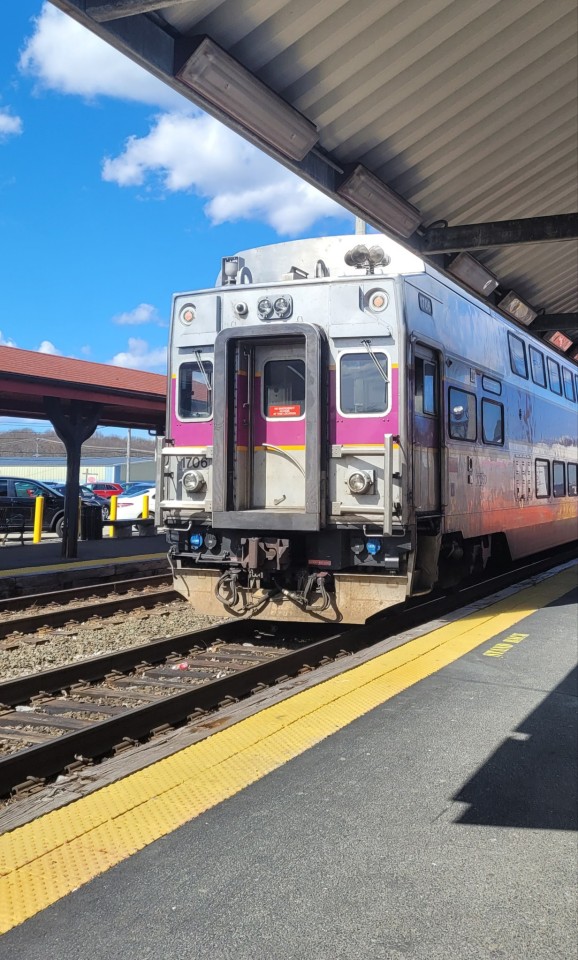
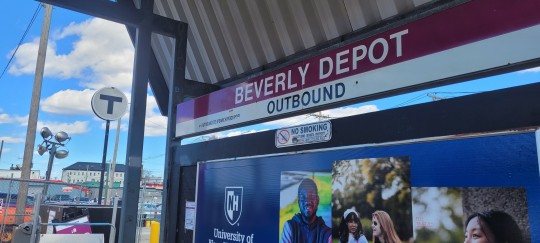
Commuter Rail @ Beverly Depot
03/31/2024
#boston#mbta#massachusetts#trains#boston transit#train#transit#american transit#boston massachusetts#mine#photography#train photography#railfan#american rail#railfanning#commuter rail#rail#massachusetts transit#Massachusetts bay transportation authority#mbta trains#public transit#commuter trains#commuter rail mbta#commuter train#eethend speaks
9 notes
·
View notes
Photo

That's the 5:00 pm Portland bound Downeaster in the distance and the towers of the of the new Leonard P. Zakim Bunker Hill Memorial Bridge (Interstate 93) spanning the Charles River. The bridge was part of the Big Dig. Cambridge, MA September 9, 2012
#downeaster#commuter train#amtk#amtrak#mbta#massachusetts bay transportation authority#2012#boston#portland#trains#passenger train#history#cambridge#massachusetts
20 notes
·
View notes
Text
ID. a tweet by user LukeBusFox that says, "My proposal for America's high-speed rail network: Simply extend the Green Line further." attached is a map of the U.S. with the MBTA Green Line extended across its entirety, labeled "Massachusetts Bay Transportation Authority Nationwide Green Line Extension." One line goes down the coast to Florida and then three that zigzag across to the West Coast, passing through major cities on their way to 1) Anchorage (via Seattle), 2) Portland, and 3) Honolulu (via San Francisco, with the line across the ocean labeled "Big Dig 2." End ID.
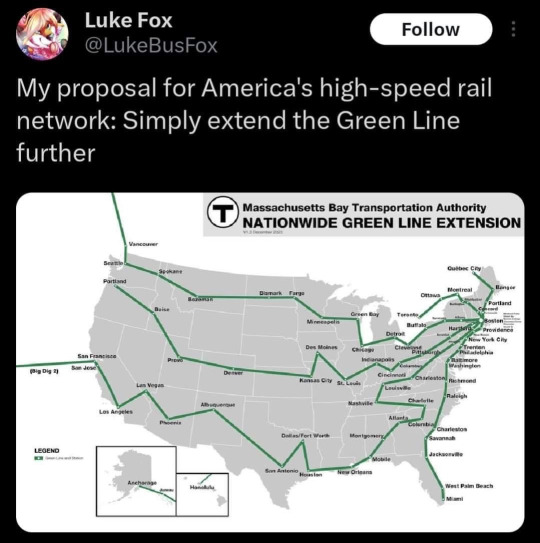
Courtesy of @nerdynarratives
6K notes
·
View notes
Text
MBTA Launches South Coast Rail Service
The Healey-Driscoll Administration, the Massachusetts Department of Transportation (MassDOT), and the Massachusetts Bay Transportation Authority (MBTA) have announced the start of service on the new Fall River/New Bedford Commuter Rail Line as part of the South Coast Rail project. For the first time in more than 65 years, southeastern Massachusetts communities now have direct passenger rail…

View On WordPress
0 notes
Text

Seventy-Eight Years Old
In this image, several EMD F3s, tied onto various other units of a more contemporary ilk, work the Bunge plant along the GM&O main line. This spot lies between Pontiac and Cayuga, in central Illinois.
[Note: this elevator seems to go by Prairie Central Coop nowadays.]
The lead locomotive seen here was built in December of 1946, thirty-one years old when this shot was taken; it would be active on the Illinois Central Gulf only for another six months. One may have thought that would constitute a good long productive life, but there would be much more.
The engine would be rebuilt to move passengers for the Massachusetts Bay Transportation Authority in the early 1980s. After that stint, this locomotive went on to haul freight again for the Idaho Northern & Pacific. It may be still kicking, now pulling tourists about, just over seventy-eight years later, but I am uncertain.
One image by Richard Koenig; taken May 22nd 1977.
#railroadhistory#railwayhistory#gulfmobile&ohio#gm&o#illinoiscentralgulf#pontiacillinois#pontiacil#bungeplant#Prairie Central Coop#emdf3#f3#f-unit
45 notes
·
View notes